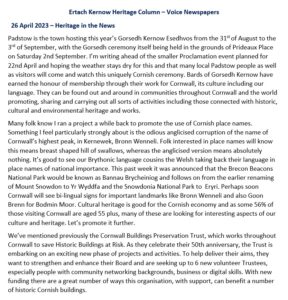Ertach Kernow - Spring travels around Cornwall
Spring travels around Cornwall are on the cards as with the Easter holiday period over there may be a slight quietening of the roads and increased ability for local residents to find car parking before the main summer tourist onslaught. We want to encourage tourists who appreciate the many aspects of our cultural and environmental heritage to come, enjoy and support them. In turn we can then appreciate them during those months when things are a little bit less hectic knowing tourist income has helped sustain them.
During those peak weeks where to go and what to do is often a question asked by local folk. Many of us want to avoid the tourist hotspots and even the beaches unless we live close and can enjoy them early in the morning or evening. The roads are often clogged near the coasts and parking almost impossible. Where to go? There are a number of heritage sites and the Cornwall Heritage Trust have recently updated their heritage map showing the sites they manage, which are free. This map also usefully shows where there is parking, a viewpoint to enjoy and walks with an indication of uneven ground. Some of these sites are small but where they are close together such as four in the far west of Cornwall and a further four in the east they can make a most enjoyable day trip including perhaps a break for lunch. Where there is an expansive area such as Castle an Dinas outside St Columb Major, which has ample parking, the few visitors that may be there make it still seem relatively quiet. Whist mentioning the Cornwall Heritage Trust I feel the need to let readers know of the advantages of membership. Not only will members help support this very worthy Cornish heritage organisation, but also benefit from admittance to a number of English Heritage venues free of charge.
Personally, I love walking or sitting on the edge of one of our Bodmin Moor reservoirs hearing the birds chirp and the occasional lowing of cattle, bleating of sheep or whinnying from the moorland horses roaming the moor. There is a large variety of birds using Colliford Lake with the top five being, Smew, Common Goldeneye, Goosander, Little Grebe and European Golden Plover. About this time last spring I mentioned about the possibility of water shortages in this article, which proved right. The various reservoirs throughout Cornwall including Colliford Lake with its vast capacity of 28,540 million litres serving most of Cornwall’s population was rather dried up with only about 15% full and leading to the current hosepipe ban. This year looks as if the reservoirs are going to be potentially even more of a mud flat than a hoped-for panoramic view with waterfowl enjoying wide expanses of flat open water. Existing levels at Colliford are now just 63% compared to nearly 80% this time last year and a previous dry year in 1995 of about 95%. So, with the hosepipe ban likely to continue my advice to gardeners is to start saving rainwater while you can.
A nice place to have some peace and quiet and keep cool during the heat of the summer or on a rainy day are churches, many also have interesting churchyard features. I’ve spent many hours enjoying both interior and surrounding church confines during summer months. Bright days often allow the stained glass to be better appreciated and some of our churches have outstanding and historic glass such as the church at St Neot mentioned in a previous article.
On the way to Polruan a few weeks ago I called in at St Wyllow Church, the Lanteglos by Fowey parish church. Now reaching St Wyllow Church is a challenge especially compared to town centre parish churches. It’s more of a cross country trip down some extremely narrow lanes, but well worth it when reached. This church was restored in 1906 by Edmund Harold Sedding, scion of the well-known Sedding family of architects. He practiced throughout Cornwall and Devon establishing himself primarily as a praised restorer of churches rather than new building work. Sedding was also a great supporter of the famed Pinwill sisters whose work can be found in churches throughout Cornwall. Sedding died in 1921 and is buried at St Carantoc Church in Crantock, one of the churches he restored, which includes a carved rood screen dating from 1905 carved by one of the Pinwill sisters.
E H Sedding was very effusive about St Wyllow Church when writing his book about Cornish churches in 1909, beginning ‘This church is spacious, solitary, beautiful for situation, and full of interesting features.’ With regard to the bench-ends he comments ‘in the body of the church bench-ends of the fifteenth and sixteenth centuries, and seventeenth century panels of exquisite design.’ He later writes ‘It may be truly said that this church was a rich storehouse of rich craftmanship, as indeed it still is. Although there are no remains of the screens, there is ample evidence of the carvers art in the roofs and bench-ends.’ One must always wonder what was lost in our smaller Cornish parish churches along with the larger better-known abbeys and monastic buildings throughout England due to the Reformation.
As E H Sedding said the church and its churchyard contain interesting features amongst which is the 14th century lantern cross in the churchyard. The tallest gothic cross in Cornwall and lost for centuries it was found buried in a trench in 1838, perhaps to save it from destruction during the upheavals of the Reformation. It was finally restored in 1841 supported on an old millstone. The octagonal shaft is highly decorated with the each of the four-sided cross having a different display. This is one of the many crosses included in the excellent Cornish publication ‘Illuminating our Lantern Crosses’ by Andrew Langdon and Ann Preston-Jones.
In historic churches, especially those that have been used by rich or powerful families it’s always interesting to find a tomb. Sadly, too few churches now have inscribed slate memorial stones on their floors, a result perhaps of Victorian ‘restoration’, but good to see as here in St Wyllow a canopied tomb and brass memorial to a member of the Mohun family. This according to Sedding has been moved at some point in its history. This family survived until the 17th century and the church’s Lady Chapel once served as the Mohun’s family chapel. The restoration of 1906 also uncovered two portions of 13th century coffin covers.
Like many churches the original rood screen has been removed, here the original door leading to a short spiral staircase that would have come out on top of the screen can still be seen. These were often blocked up following removal of the screen, this one at St Wyllow being reopened in 1906 and the discovery of pieces of carved imagery were made. The most interesting surviving were broken pieces of an alabaster panel showing the rather gruesome martyrdom of St Laurence.
Not sufficient people look up, something that we should all do when spending time in Cornish towns, better to appreciate architecture often unmarred by 20th century commercial shopfronts and signs. It also applies to our churches where some have lovely original roofing as is the case at St Wyllow’s with its excellent late medieval wagon roof, including decorative carved bosses. Besides the roof St Wyllow has some amazing bench ends carved with heraldic emblems relating to the families who owned manors within and around this parish. There are also the panels originally part of pews used by leading families. Sedding comments ‘The open carved work heraldic designs on the upper panels are of great interest and value to the county where so much has been destroyed by indifferent and mistaken restoration.’ They really are a great source of information relating to historic use of the church by early families and Sedding is quite right in what he says about restoration in some of Cornwall’s churches, which in some cases is sadly almost cultural vandalism.
Now one small plaque on the wall held special interest for me. I’d seen an image online and hoped it was still there and not succumbed to some 20th century tidying or such like. It is a memorial to Captain Hugh Pearce late of His Majesties cutter Hart and Superintendent of the Water Guard at the Islands of Guernsey, Jersey and Alderney. It was in 1806 that my three times great grandfather George joined his brother William, both born in St Austell to serve on the revenue cutter Hart under Hugh Pearce. For the next eleven years George and William were employed with Captain Pearce hunting down smugglers in and around the Channel Islands. The English Channel was a notorious smuggling area and with the Napoleonic War taking place import and exports were either banned or taxed to the hilt. During that eleven years George would meet his future wife Elizabeth in Lyme Regis with whom he would have ten children. By 1817 the Hart had reached the end of its life as a revenue cutter and was broken up. George was transferred to a land based preventive station at Clovelly and Captain Pearce retired to Polruan. Hugh Pearce was obviously proud of his work in the revenue service, and I was pleased to see his memorial still there. Sadly, I have no idea where he is buried at St Wyllow Church, this year being the bi-centennial of his death in 1823.
Hopefully many Cornish residents will take the opportunity to get out and about, rain or shine, before the tourist deluge later this year. Plenty to see, do and enjoy here in Cornwall and with a variety pubs and restaurants providing quality Cornish fare for lunch. I’m off to Porthleven this week to give a talk so looking forward to a day out there.
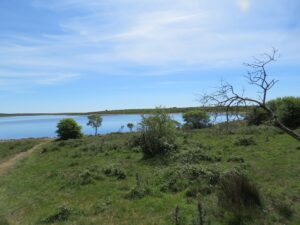
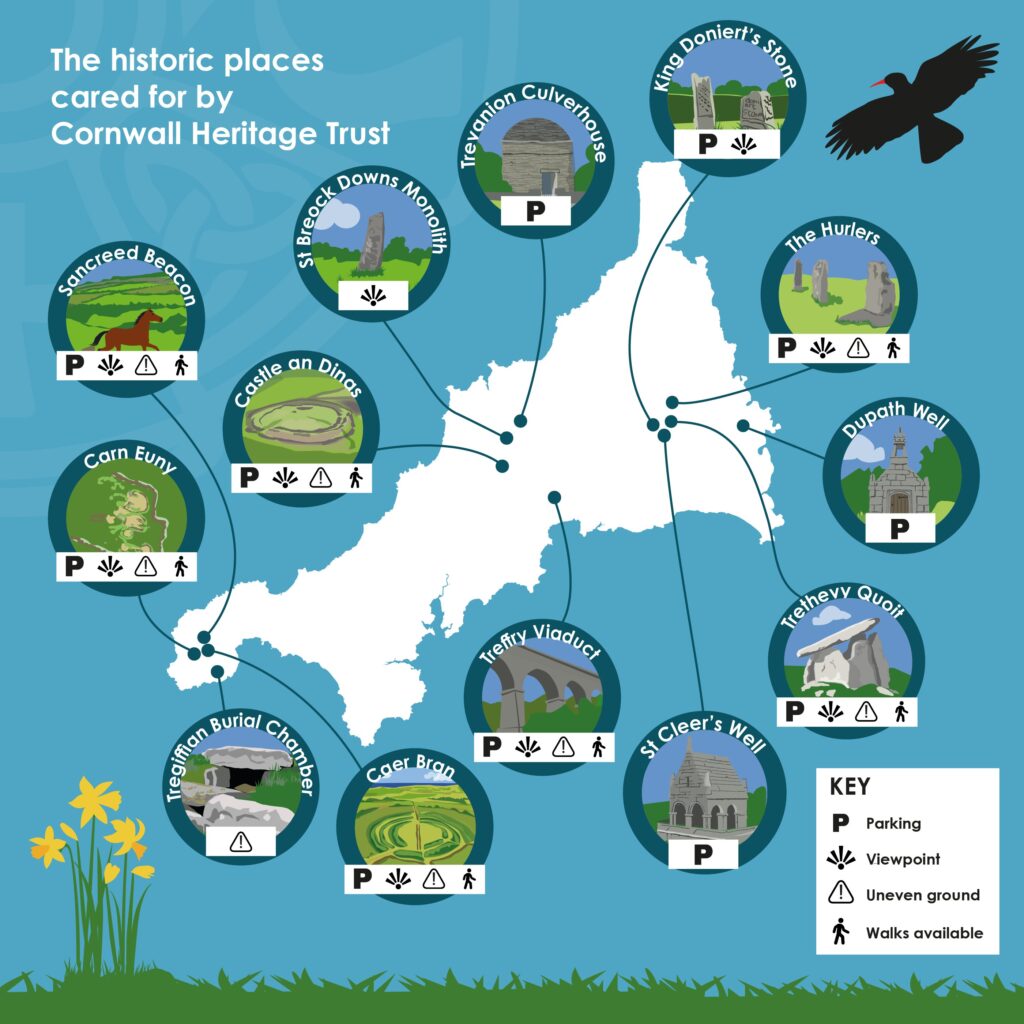
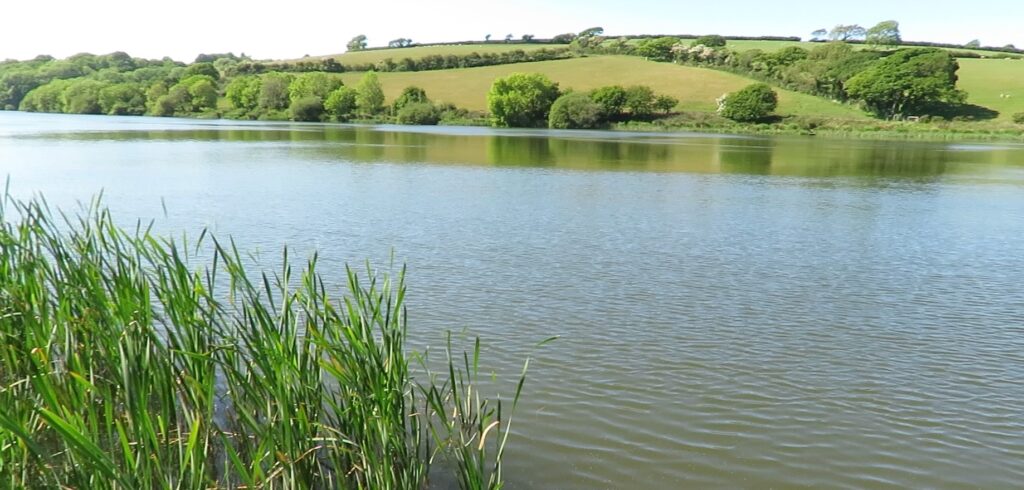
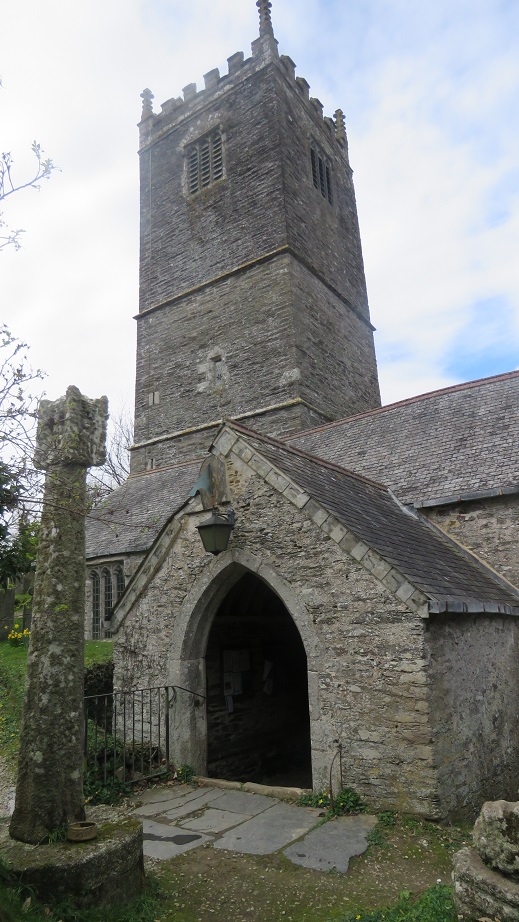
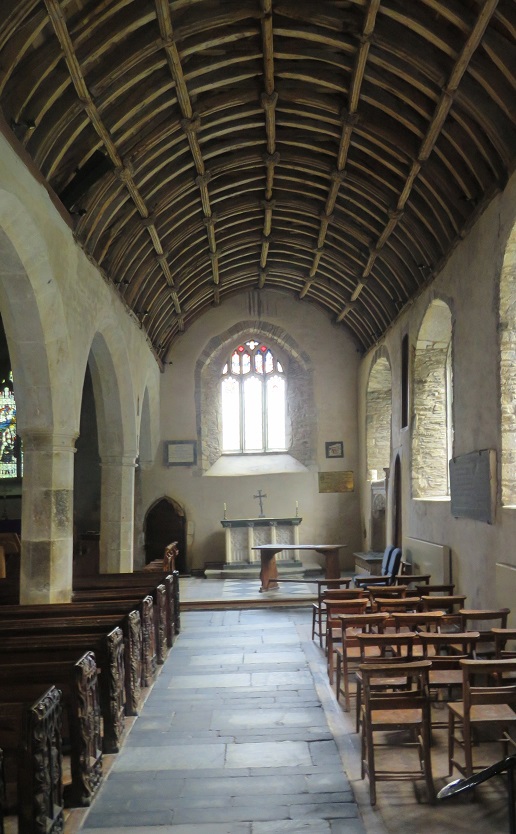
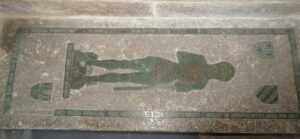
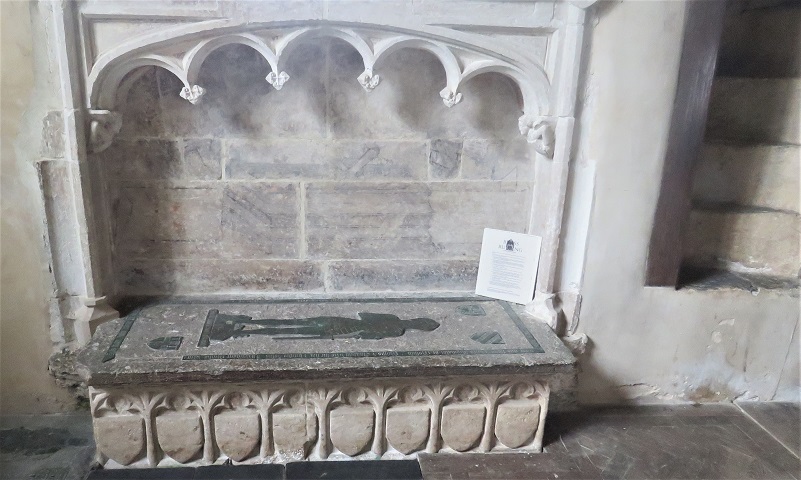
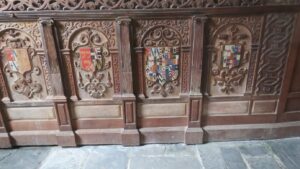
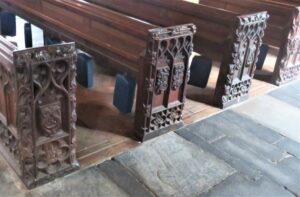
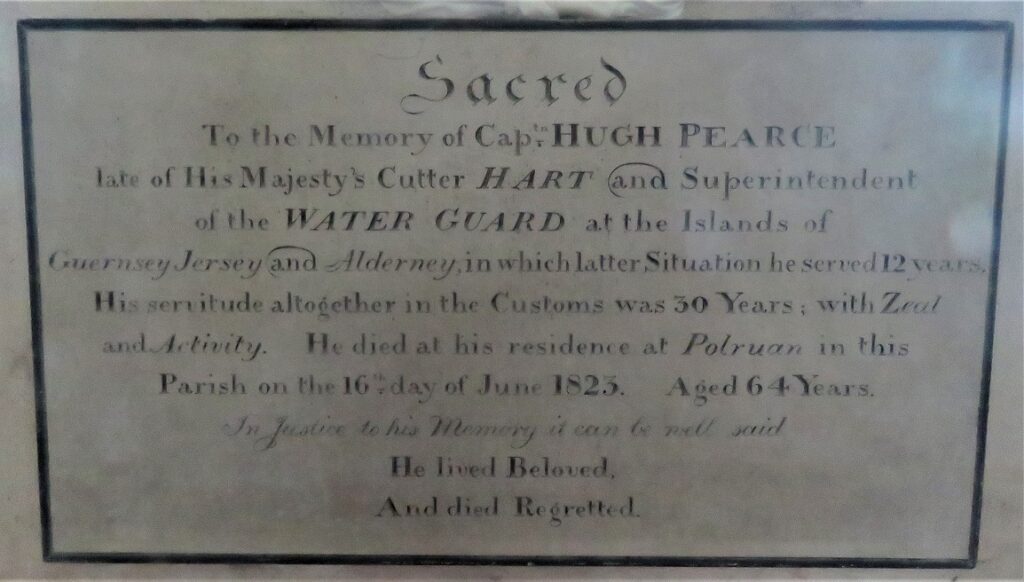
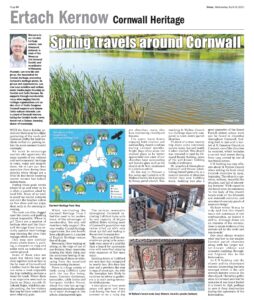
![Ertach Kernow - 26.04.2023 [2] Spring travels around Cornwall](https://www.cornwallheritage.com/wp-content/uploads/2023/05/Ertach-Kernow-26.04.2023-2-254x300.jpg)
